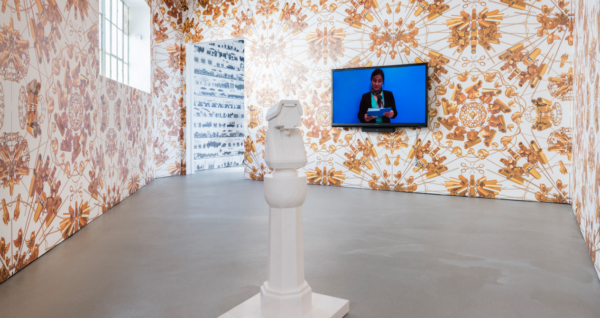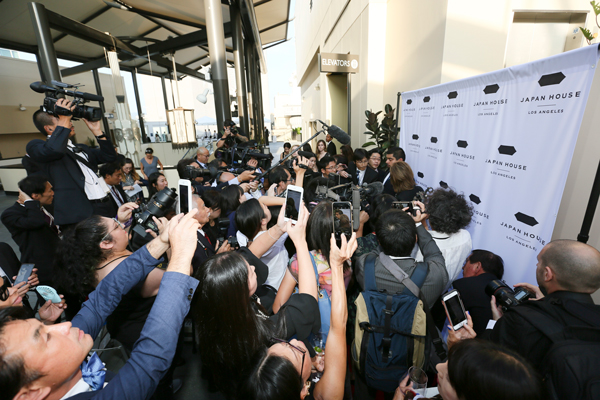Your cart is currently empty!
SHOPTALK

 AI WEIWEI IN LA
AI WEIWEI IN LA
We haven’t seen much of Chinese artist Ai Weiwei in these parts since LACMA presented his installation “Circle of Animals/Zodiac Head” in 2012. This fall he returned with a well-orchestrated splash—with three high-profile exhibitions opening in LA, all within two weeks. Splashiest of all was the show at the Marciano Art Foundation (through March 3, 2019) featuring large-scale installations such as Sunflower Seeds, originally made for Turbine Hall at the Tate Modern in 2010. The millions and millions of “seeds” form a low but very large square mound in the middle of the Theater Gallery, and each piece was fired, then painted by hand, in Jingdezhen, China—making use of ancient porcelain crafts and giving work to hundreds of people there.
Ai was also featured in two gallery shows—one at UTA Fine Arts in Beverly Hills (through Dec. 1) and the other at Jeffrey Deitch in Hollywood (through Jan. 5, 2019). UTA’s “Cao/Humanity” emphasized themes of displacement and refugees, with most of the main gallery taken up by an installation of “blades” of grass made in white marble. Deitch showcased a number of the artist’s famous sculpture and installations, including Grapes, made up of a cluster of stools, and Ton of Tea made up of compressed pu-er tea.

It’s good to see that Ai hasn’t softened his politics since leaving China after getting his passport—he’s now mainly based in Berlin. During the UTA preview, someone asked his thoughts on U.S. politics. He snapped, “You have the government you deserve! Didn’t you all vote for him?” Later I tried to explain that, actually, the man in the White House was NOT the choice of the plurality, but he was loathe to listen to details… He did say, in answer to my question, that Chinese people “most definitely deserve the government they have. No one will stand up.”
NEW ART VENUES, NOW AND FUTURE
There are only three branches of Japan House, the prestigious outpost of Japan’s Ministry of Foreign Affairs meant to showcase Japanese art, design and culture. The first two are in London and Sao Paulo, and lucky for Los Angeles, we got the third one! It opened at the end of August in the Hollywood & Highland complex, located on the two levels, with a gallery/store on the second floor (which had a soft open earlier in the year) and conference room, library and high-end restaurant on the fifth floor.

The official opening was celebrated August 24th with a champagne reception and dinner for several hundred guests, with a program mc’ed by George Takei (yes, he of Star Trek fame), interspersed with lots of speeches and two rousing entertainers. The Japanese dance company Rhizomatiks Research moved in hypnotic synchronicity with propulsive music and video projection, and singer/songwriter Yoshiki brought in fans from far away. Or at least from the Bay Area, I met one dude who had won one of the fan tickets and came down just for the mini-concert. The restaurant wasn’t opened yet, but a tour revealed one of the most panoramic views of the city from any restaurant. I put it on my “Must Visit Again” list!
On October 18, the Museum of Contemporary Art San Diego (MCASD) broke ground for its $95 million expansion project in La Jolla. The branch was founded in 1941 as The Art Center in La Jolla, and in recent years space proved inadequate for showing its collection of more than 4,700 works that date from the 1950s. In the new plan there will be an addition on the southern side providing two levels of galleries, with tall windows to let in natural light and to allow coastal views. The expansion has been designed by Annabelle Selldorf of Selldorf Architects.
Another expansion down south was announced earlier this year—in June the Orange County Museum of Art (OCMA) closed down its four-decade home in Newport Center, after completing sale of the site, and is now well-funded to underwrite its new abode in Costa Mesa, right next to the Segerstrom Center for the Arts. Talk about a synergistic location! The new, futuristic-looking building designed by Thom Mayne and his firm Morphosis will boast 52,000 square feet of space, with 25,000 square feet for galleries and 10,000 square feet for education, performances and other public events. Groundbreaking for the new OCMA is scheduled for next year, and completion is expected in 2021.
In the meantime, starting in October, OCMA is presenting pop-up exhibitions and programs at the South Coast Plaza Village in Santa Ana.
FRIEZE LOS ANGELES
Los Angeles is finally going to experience Frieze, the art fair originated by the British magazine of the same name—next February 14–17. Earlier this year Bettina Korek, arts advocate and founder of For Your Art, was appointed executive director of Frieze Los Angeles, and the list of 68 galleries participating was recently published. In addition to stalwart LA-based galleries such as Blum & Poe, David Kordansky, L.A. Louver, Marc Selwyn, and Susanne Vielmetter, there will be a few of our younger galleries, such as Anat Ebgi and Parker Gallery, joining in. We’ll also see New York and international participants, including two major South Korean galleries, Gallery Hyundai and Kukje Gallery. The venue is Paramount Pictures Studio, the site of Paris Photo—which was lots of fun but bit the dust after two attempts at cracking the LA art market.

How is Frieze LA going to distinguish itself? “The fact that Frieze started as a magazine, it continues to take an editorial approach,” Korek said in a telephone interview. “An international fair was bound to establish roots here, as LA has indubitably become one of the most prominent art cities in the world.”
Korek points to the list of participating galleries. “It’s the first fair to bring that caliber of international galleries together with the LA mainstays and emerging talents under one roof,” she said. Why the Paramount lot? “There are surprisingly few locations in LA that can accommodate this kind of event. It’s near Hollywood, a hub for seeing art. Kulapat is working with Frieze to design the tent, that will be a focused area for the galleries. Paramount also provides the backlot experience, so the fair will have these two distinct locations.” She’s referring to Kulapat Yantrasast, the architect behind the successful reno for ICA LA in downtown LA and other art spaces. The famous backlot replicates classic American city streets circa 1900 and will be filled with art installations curated by Ali Subotnick, and talks in the Lansing Theater will be organized by Hamza Walker, director of LAXART.
Tanya Bonakdar, who inaugurated the LA branch of her gallery this summer, has had good experience with the fair. “The gallery has exhibited with Frieze London and New York for many years now,” she said. “Frieze is one of the leading contemporary art fairs, and we are delighted to participate in the first Los Angeles iteration.”
Frieze LA will overlap with our own homegrown contemporary art fair, Art Los Angeles Contemporary, taking place as before at Santa Monica’s Barker Hangar, Feb. 14–17. On quick glance, one notes several defections over to Frieze—Anat Ebgi, Francois Ghebaly, Night Gallery. Whether that overlap will prove symbiotic—with art aficionados shuttling between both fairs—remains to be seen. Is more more, or sometimes less?
“Obviously, this is an art fair and we want this to establish a viable marketplace for dealers,” Korek said. “My dream for the fair is that it evolves into a more civic event that draws people to Los Angeles, but also stimulates activity here.”
 AI WEIWEI IN LA
AI WEIWEI IN LA